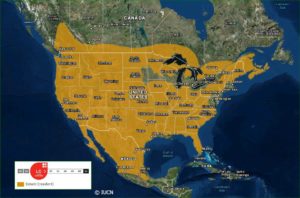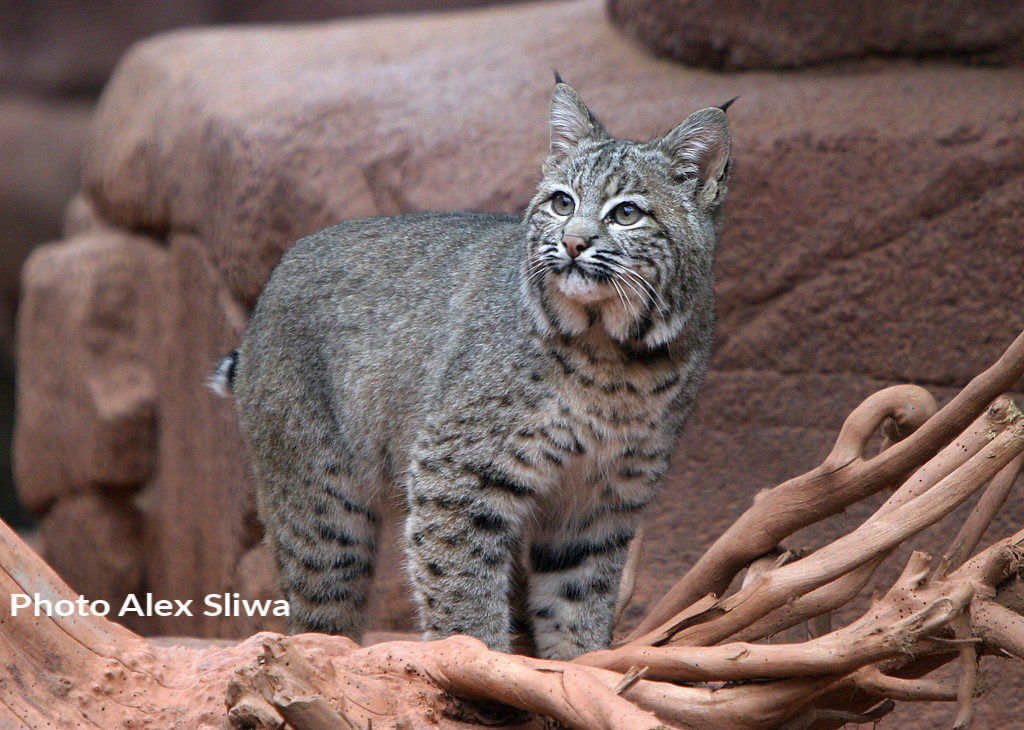- HB Length: 65-105 cm (25-41″)
- Tail Length: 9-11 cm (3.5-4.3″)
- Height: Appr. 53 cm (21″)
- Weight: 6-13 kg (13-29 lbs)
- Pop. Trend: Stable
The Bobcat Lynx rufus is the most successful wild cat species in North America, and more easily recognized than many other small wild cats. Their soft, dense coat is light grey to reddish brown, and they are randomly barred and spotted with black or dark reddish brown. The fur along the middle of the back is usually darker, while the underparts are whitish, and also spotted.
In 2007, a rare melanistic Bobcat was captured in Florida. Less than a dozen black Bobcats have ever been reported, so officials took DNA samples and blood tests, then released the cat back into the wild.
The short ‘bobbed’ tail, approximately 7.5 – 15 cm long, is marked with several indistinct dark bands, and black tipped only on the topside. The bob tail is possibly a past adaptation to cold conditions. Bobcats are short stocky cats with muscular legs, their hind legs being slightly longer than their forelegs. Their relatively high shoulder height and thick fur make them appear much larger than they really are. The large ears are black on the outside, with a white central spot, and their eyes are a yellowish brown. Their ear tufts, if present, are much smaller than those of the Canada lynx Lynx canadensis, as is the ruff framing their face. The largest Bobcats are found in Canada and the western USA, while the smallest are found in Mexico.
Distribution

Bobcats are found from southern Canada, down through the USA to northern Mexico. As habitat generalists, they live in a wide variety of areas, including all types of forest, coastal swamp, desert and scrubland. Only large, intensively cultivated areas without adequate surface cover appear to be unsuitable habitat. Their range in Canada has been expanding northward with forest clearance and warmer winters.
Unlike the Canada lynx, they are not found in the northern latitudes where deep snow restricts their movements. They generally favour low and mid elevations, but have been found at 3,500 metres in Mexico.
Males have an established range which includes the smaller ranges of several females, and often overlaps partially with other males’ territories. Female ranges are more exclusive. Young males disperse and travel long distances in search of an unoccupied territory, while females often settle near or partially within the range of their mother.
Bobcat home range sizes vary widely, from 6 km² in southern California to 325 km² in New York. Although there are no exact figures, population density estimates range from 48 cats per 100 km² in Texas to 11 per 100 km² in Virginia.
A recent population analysis (2011) found that Bobcat numbers have increased throughout the majority of its range since the 1990’s [1]. Forty-eight US states, seven Canadian provinces and Mexico were surveyed, with all locations except Florida reporting increased populations. The Bobcat is found in each of the contiguous states except Delaware. Its US population was estimated to be from 2,353,276 – 3,571,681 individuals. The population in Mexico is not well known, and it appears to be very rare in some central areas.
Ecology
These tough little cats survive mainly because they are secretive, cantankerous, will eat almost any type of prey and can live in almost any kind of habitat. Like their close relatives the Canada Lynx, they prey primarily on rabbits, but are less of a specialist.
They are reasonably tolerant of human disturbance, adapting well to altered habitat. They hunt by day or night, and as opportunistic feeders, prey on whatever is most abundant. Although they are heavily persecuted as livestock killers, the majority of their prey species are destructive agricultural pests. Despite their small size, Bobcats can also be effective predators of deer, taking animals weighing up to ten times their own body weight which are generally killed when resting. They are mainly ground dwellers, but can climb trees with ease and are excellent swimmers.
Reproduction
Bobcats are solitary animals, and the males and females associate only during the breeding season, which runs from December to April, with the earliest breeding occurring at the lower latitudes. Only resident cats with established territories raise litters. While males may breed with several females, the females typically mate with only one male
Gestation is 50 – 70 days, with one to six, usually two to four, kittens being born in a den, hollow log, under a rock ledge or in dense thickets. The kittens are born with faint marks on their back and sides, and dark streaks on their faces that fade as they grow. They open their eyes after about nine days. They nurse for about three to four months, and at five months of age the mother takes them out hunting. They stay with her until the next breeding season. Bobcats are sexually mature at about one year for the females, and two years for the males. They have been known to live over 33 years in captivity, and 12 – 13 years in the wild.
Conservation
Bobcats are legally harvested for the fur trade in 38 US states, and in seven Canadian provinces. In Mexico, the Bobcat is legally hunted in small numbers as a trophy animal. There appears to be little illegal international trade, although within the US, molecular forensics techniques have determined that skins reported as originating from an area with a high bag limit were probably illegally taken from an area with a lower limit.
The Bobcat is now the leading wild cat species in the skin trade, with most exports coming from the US. In 2000-2006 the average annual export of skins was 29,772, with an all-time high of 51,419 skins exported in 2006.Demand for Bobcat pelts is being driven by Asian countries with growing economies. Although this harvest seems likely to continue, it is regulated. The far more serious threat to these cats is the continuing habitat fragmentation, loss of habitat, and persecution by farmers and ranchers.
A California study (2012) found the primary source of mortality in Bobcats was notoedric mange, or feline scabies. Researchers discovered a direct link from the infected cats to anticoagulant rat poisons. Eating of the poisoned rodents resulted in 51% of collared Bobcats dying during the study. Other carnivores such as Cougar Puma concolor were equally affected.
On a regional level, the Bobcat is totally protected in ten USA states; in Canada hunting and trade is regulated; and in Mexico hunting is regulated in five states and shooting of suspected livestock predators is permitted. The degree to which these little cats have been studied and managed in North America makes them probably the most thoroughly examined species in international trade today.
![]() [1] Roberts Nathan M, Crimmins Shawn M. 2010. An update of Bobcat Lynx rufus population status and management in North America: Evidence of large-scale population increase. Journal of Fish and Wildlife Management 1(2):XX-XX; e1944-687X. doi: 10.3996/122009-JFWM-026R
[1] Roberts Nathan M, Crimmins Shawn M. 2010. An update of Bobcat Lynx rufus population status and management in North America: Evidence of large-scale population increase. Journal of Fish and Wildlife Management 1(2):XX-XX; e1944-687X. doi: 10.3996/122009-JFWM-026R
Compare the Bobcat to the larger Canada Lynx.
Range map IUCN Red List 2008
Updated 2014


39 Responses